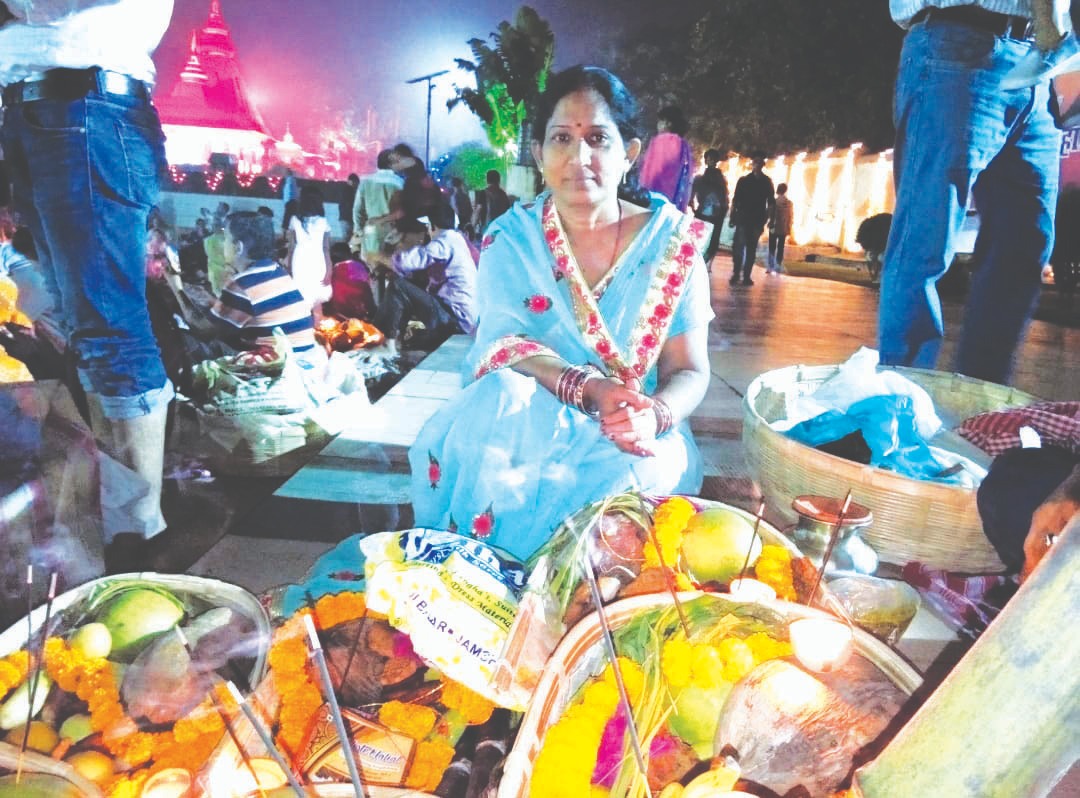Kamalika Mishra
Down the memory lane of my childhood in Bihar and Jharkhand, I wandered through days steeped in nature’s abundance – endless green fields, mango and jackfruit trees laden with fruits, litchi groves shimmering in sunlight, and the sweet, melodious calls of the cuckoo drifting through the air. Growing up amid such beauty was enchanting, yet it was the festivals that added bursts of colour, joy and togetherness, turning each celebration into a vivid portrait of family and community life.
Diwali, Bhai Dooj, and Chhath Puja, each arriving one after another, held a special magic, filling our homes with excitement and anticipation. Diwali, the grand festival of lights, was followed by Bhai Dooj (known as Bhar-Dutiya in Bihar). On the sixth day after Diwali came Chhath Puja, usually in the crisp autumn of October or November. Among these, Chhath has always commanded the deepest reverence and witnessed the widest celebration across Bihar, Jharkhand, Eastern Uttar Pradesh and parts of Nepal.
I remember waking before dawn during these festivals, drawn to the gentle flicker of earthen oil lamps that illuminated our courtyard. The air was rich with the fragrance of freshly prepared thekua – traditional sweets made from wheat flour and jaggery and kheer – the sweet rice pudding simmered in milk. Soulful folk songs in Maithili and Bhojpuri, sung by our elders and immortalized by Smt. Sharda Sinha, the beloved Bihar Kokila, drifted through every lane, wrapping the village in devotion.
One song, soft yet resonant, floated through the air from every loudspeaker, filling every nook and corner: “Pahile pahil ham kainee, Chhathi Maiya vrat tohar. Kariha kshama Chhathi Maiya, bhool-chook galti hamar.” (For the first time, I have undertaken your fast, O Chhathi Maiya! Please forgive any mistakes I may have made.)
Its melody carried the humility and sincerity of a devotee’s first experience with Chhath Puja, a festival rooted in gratitude towards the God Sun and Chhathi Maiya, whose blessings sustain life itself.
Offerings for the Sun God were arranged with meticulous care and the entire village seemed to awaken together in shared faith. The soft glow of earthen lamps, the sweet offerings prepared with devotion, and the melodic chants of folk songs created an atmosphere of reverence and serenity that still stays with me, a reminder of the enduring spirit of the festival.
Many years later, standing on the banks of the Yamuna River in New Delhi during Sandhya Arghya (the evening offering), my childhood memories bloomed full. Women draped in vibrant new saris and men in crisp kurtas carried baskets filled with thekuas, tikari, diyas (earthen lamps), coconut and seasonal fruit offerings like bananas and sugarcane stalks for the Surya Dev, the Sun God. The sugarcane symbolized nature’s abundance and the sweetness of life.
I still remember a little girl standing beside me who whispered, “Didi, will our prayers reach the Sun God?” In her innocent eyes, I saw how devotion transcends age, place, and time. Another scene remains vivid in my heart – an elderly man, his hands steady despite his frailty, offering ‘thekua’ with closed eyes and a serene smile. Nearby, children tried to imitate the rituals, their tiny hands placing fruits and flowers into the river. Laughter and reverence mingled like soft wind and sunlight, forming a mosaic of faith, warmth, and unity.
As dusk fell, earthen lamps floated gently on the water, their flickering flames mirrored in the golden horizon. From every corner, folk songs rose in gentle unison, voices intertwined in harmony, echoing love and devotion. These memories remain etched in my heart, shaping my faith and cultural pride.
Chhath Puja: A Discipline of Faith and Devotion
Chhath Puja, in legend and practice, is more than a ritual; it is a living hymn to nature, celebrating the delicate balance of earth, water, and sky, and standing as a testament to harmony, purity, equality, and collective devotion. Dedicated to Surya Dev (the Sun God) and Chhathi Maiya, the festival is observed with unwavering devotion and strict adherence to purity. It is celebrated twice a year – once in the lunar month of Chaitra as Chaiti Chhath, and again in Kartik as Kartik Chhath, the latter being more widely observed. Kartik Chhath begins on Kartik Shukla Chaturthi and concludes on Kartik Shukla Saptami, usually falling between October and November in the Gregorian calendar.
The main worshippers, called ‘Parvaitin’ (derived from the Sanskrit word – ‘Parv’ meaning festival), are usually women, though men also take part, as the festival transcends gender and unites everyone in faith. Over four spiritually charged days, devotees perform rituals that culminate in a 36-hour ‘Nirjala vrat’, a fast without even a sip of water – testing both physical endurance and spiritual strength.
The Four Sacred Steps of Devotion
The first day, Nahay-Khay, marks ritual purification through a sacred bath, followed by a simple satvik meal prepared without salt, onion, or garlic, ensuring complete purity. The second day, Kharna, involves a day-long fast broken in the evening with offerings of gur (jaggery) and kheer (sweet rice pudding), symbolizing devotion and self-restraint. On the third day, during Sandhya Arghya (evening offering), devotees stand in rivers, ponds, or other water bodies at sunset to present fruits, lamps, and prasad such as thekua, peethha (rice laddu), tikri, sugarcane, coconut, banana, and other seasonal fruits to the setting Sun, expressing gratitude and seeking blessings for prosperity and well-being.
The festival concludes on the fourth day with Usha Arghya at dawn, when devotees offer prayers to the rising Sun, marking the completion of the fast and a moment of spiritual renewal. These offerings hold deep cultural and religious significance, with recipes and traditions lovingly passed down through generations. Through these rituals, Chhath Puja celebrates purity, devotion, and an enduring legacy of ecological and spiritual wisdom.
Eternal Dawn of Faith and Culture
Rooted in Vedic traditions, Chhath Puja is one of India’s oldest festivals, linking faith, nature, and humanity. The Vedas associate Chhathi Maiya with Usha, the goddess of dawn, with devotion extending to Pratyusha, the evening glow, celebrating the Sun’s eternal rhythm. In the Ramayana, Sita performed Surya Shashthi for her sons, Lava and Kusha, while in the Mahabharata, Kunti is mentioned as receiving blessings for Karna. In the folk traditions of Bihar, Jharkhand, and eastern Uttar Pradesh, Chhathi Maiya is revered as the sister of Surya Dev and protector of children.
Celebrating Chhath Beyond Borders
During my stay in Mauritius, accompanying my husband, a Government of India official, I will have the privilege this year to witness the grand preparations and celebrations of Kartik Chhath Puja in a vibrant and heartfelt way. The festival will surely rekindle my childhood memories and connect my present life in Mauritius with my roots in Bihar and Jharkhand, thousands of miles away.
This year, people across different sections of Mauritian society and the Indian diaspora will be observing Chhath Mahaparv with devotion. The festival will begin with Nahay-Khay, followed by Kharna on Sunday, 26th October; Sandhya Arghya on Monday, 27th October; and Usha Arghya on Tuesday, 28th October, at various locations across the island.
As Mauritius is all geared up to celebrate Chhath Puja in the pure traditional way, the air will be filled with the spirit of celebration, humming with rhythmic dhol beats, devotional songs and the vibrant colours of traditional attire, creating moments of unity and shared happiness. I am eagerly waiting to experience its grandeur and divinity.
Standing knee-deep in the seaside waters and offering prayers to the rising and setting Sun will certainly evoke a profound connection, linking past and future, India and Mauritius with shared faith and devotion and shining as a symbol of unity where tradition meets modernity.
Chhath Puja has transcended borders and is celebrated by the Indian diaspora worldwide. Wherever people from Bihar and neighbouring regions have settled, they have carried this festival with them, keeping its spirit alive through community gatherings and collective worship. The Government of India has nominated ‘Chhath Mahaparva’ for inclusion in UNESCO’s Intangible Cultural Heritage List, recognizing its universal message of gratitude, purity, and ecological harmony.
Let us carry this devotion in our hearts, singing the timeless words of my beloved singer, the late Smt. Sharda Sinha: “Ugihein Sooraj Gosaiyan, hamar manwa harshit hoi…” (The Sun God rises, and my heart overflows with joy). Jai Chhathi Maiya!

*****
The views expressed are personal.
Mrs. Kamalika Mishra, an Indian expatriate and freelance writer, passionately preserves the timeless values of faith, family, and heritage through her writing. Her work, featured in ‘Storyweaver’ and other publishing platforms, inspires cultural and social awareness across generations.
Chhath Puja, in legend and practice, is more than a ritual; it is a living hymn to nature, celebrating the delicate balance of earth, water, and sky, and standing as a testament to harmony, purity, equality, and collective devotion.



